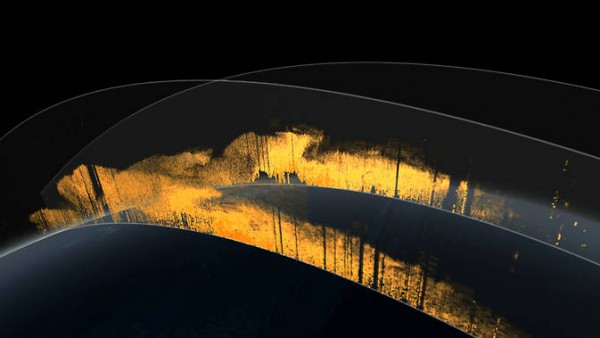NASA Satellite Reveals How Sahara Dust Fertilizes the Amazon Rainforest
| Ana Verayo | | Feb 25, 2015 04:37 AM EST |
(Photo : NASA Goddard's Scientific Visualization Studio) The lidar instrument aboard the CALIPSO satellite distinguishes dust from other particles based on optical properties.
The Amazon rainforest in South America is apparently being fertilized by phosphorus that originates from a dry lake bed in the Sahara desert in Africa, according to a new study.
Scientists have already known for decades that massive plumes of dust are carried off by winds and weather from the largest desert in the world. These plumes travel for thousands of miles across the Atlantic and eventually settle at the basin deep of the Amazon forest.
Like Us on Facebook
The study was supported by satellite data from NASA's CALIPSO (Cloud-Aerosol Lidar and Infrared Pathfinder Satellite Observation) satellite whose mission is to observe the structure of clouds and airborne particles around the planet.
CALIPSO's data reveals for the first time how much Saharan dust is dramatically moving from Africa across the Atlantic Ocean and into South America.
According to atmospheric scientist Hongbin Yu, there's an average of 182 million tons of dust transported from the western edge of the Sahara every year and 28.8 million tons eventually settles in the Amazon basin.
Sahara dust is loaded with phosphorus, and phosphorus is an essential nutrient that promotes plant growth. Past research shows that 90 percent of the soil in the Amazon is apparently phosphorus deficient. Scientists believe rain and rivers wash away many of these soil nutrients, especially phosphorus from the rainforest.
In a bizarre twist of fate across the Atlantic, the Sahara desert is rich in phosphorus that originates from an ancient lake bed in Chad called the Bodele Depression.
Researchers analyzed satellite data and collected dust samples from research sites in Chad, Barabados and Miami and concluded that 22,000 tons of phosphorus gets to the Amazon from the Sahara every year, but the same amount is washed away by the rains.
Researchers also found out that not the same amount of dust gets carried away across the ocean each year. They measured an 86 percent difference from the largest plume of dust seen in 2007 and the smallest one in 2011.
Scientists believe this phenomenon can be attributed to the amount of rainfall on a strip of land located in the Southern border of the Sahara called the Sahel. If the rainfall amount is higher, the dust that gets lifted is lesser but scientists still need further research to link the two events.
These findings were published in the journal, Geophysical Letters.
TagsNASA Satellite Reveals How Sahara Dust Fertilize the Amazon Rainforest, NASA CALIPSO, NASA, sahara desert, Amazon rainforest, NASA satellite amazon rainforest sahara dust fertilization, amazon basin
©2015 Chinatopix All rights reserved. Do not reproduce without permission
EDITOR'S PICKS
-

Did the Trump administration just announce plans for a trade war with ‘hostile’ China and Russia?
-

US Senate passes Taiwan travel bill slammed by China
-

As Yan Sihong’s family grieves, here are other Chinese students who went missing abroad. Some have never been found
-

Beijing blasts Western critics who ‘smear China’ with the term sharp power
-

China Envoy Seeks to Defuse Tensions With U.S. as a Trade War Brews
-

Singapore's Deputy PM Provides Bitcoin Vote of Confidence Amid China's Blanket Bans
-

China warns investors over risks in overseas virtual currency trading
-

Chinese government most trustworthy: survey
-

Kashima Antlers On Course For Back-To-Back Titles
MOST POPULAR
LATEST NEWS
Zhou Yongkang: China's Former Security Chief Sentenced to Life in Prison

China's former Chief of the Ministry of Public Security, Zhou Yongkang, has been given a life sentence after he was found guilty of abusing his office, bribery and deliberately ... Full Article
TRENDING STORY

China Pork Prices Expected to Stabilize As The Supplies Recover

Elephone P9000 Smartphone is now on Sale on Amazon India

There's a Big Chance Cliffhangers Won't Still Be Resolved When Grey's Anatomy Season 13 Returns

Supreme Court Ruled on Samsung vs Apple Dispute for Patent Infringement

Microsoft Surface Pro 5 Rumors and Release Date: What is the Latest?










